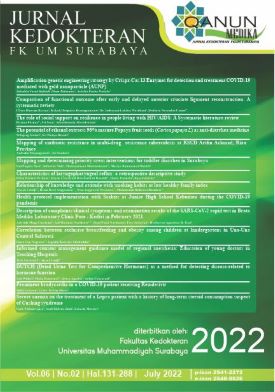Characteristics of Laryngopharyngeal Reflux: A retrospective descriptive study
Abstract
Laryngopharyngeal reflux (LPR) is a condition of reverse flow of gastric and duodenal fluid that reaches the aerodigestive tract, causing inflammation in the upper respiratory tract. Reflux Symptoms Index (RSI) and Reflux Finding Score (RFS) have been used as instruments to determine the symptoms and signs in LPR patients. This study aims to find out the characteristics of patients with LPR. A retrospective descriptive study was performed using medical records as a source of information to obtain the characteristics of patients with LPR in ENT Outpatient Clinic Dr. Soetomo General Academic Hospital Surabaya. The study population is all patients that has been diagnosed with LPR based on RSI >13 and RFS >7 in the period 2018-2019. Our finding shows the total patients diagnosed with LPR were 58. There were 45 patients diagnosed solitarily according to the results of the RSI score, while the RFS was 34 patients. The total patients diagnosed according to both of RSI and RFS were 21 patients. In this study, 67.24% patients with LPR were female, while the male patients were 32.76%. Most patients with LPR belonged to 50 – 59 years (25.86%). The distribution of occupation shows the highest number of patients is unemployed (43.10%). The most frequent and severe complaints from LPR patients were throat clearing, sensation of something sticking in throat or lump, and excess throat mucus or postnasal drip. The laryngoscopy findings compiled on the RFS showed that the most common signs in LPR patients were subglottic edema, thick endolaryngeal mucus, and posterior commissure hypertrophy.
Full text article
References
Belafsky, P. C., Postma, G. N., & Koufman, J. A. (2001). The validity and reliability of the reflux finding score (RFS). Laryngoscope, 111(8), 1313–1317. https://doi.org/10.1097/00005537-200108000-00001
Belafsky, P. C., Postma, G. N., & Koufman, J. A. (2002). Validity and Reliability of the Reflux Symptom Index (RSI). Journal of Voice, 16(2), 274–277. https://doi.org/10.1016/S0892-1997(02)00097-8
Bor, S., Kitapcioglu, G., & Kasap, E. (2017). Prevalence of gastroesophageal reflux disease in a country with a high occurrence of Helicobacter pylori. World Journal of Gastroenterology, 23(3), 525–532. https://doi.org/10.3748/wjg.v23.i3.525
Chen, T. S., Doong, M. L., Chang, F. Y., Lee, S. D., & Wang, P. S. (1995). Effects of sex steroid hormones on gastric emptying and gastrointestinal transit in rats. American Journal of Physiology - Gastrointestinal and Liver Physiology, 268(1 31-1), 171–176. https://doi.org/10.1152/ajpgi.1995.268.1.g171
Johnston, N., Ondrey, F., Rosen, R., Hurley, B. P., Gould, J., Allen, J., … Altman, K. W. (2016). Airway reflux. Annals of the New York Academy of Sciences, 1381(1), 5–13. https://doi.org/10.1111/nyas.13080
Junaid, M., Qadeer Ahmed, S., Kazi, M., Khan, H. U., & Sohail Halim, M. (2020). Laryngopharyngeal Reflux Disease: Outcome of Patients After Treatment in Otolaryngology Clinics. Cureus, 12(12), 1–9. https://doi.org/10.7759/cureus.12195
Kamani, T., Penney, S., Mitra, I., & Pothula, V. (2012). The prevalence of laryngopharyngeal reflux in the English population. European Archives of Oto-Rhino-Laryngology, 269(10), 2219–2225. https://doi.org/10.1007/s00405-012-2028-1
Koufman, J, A. (1991). The otolaryngologic manifistation of reflux disease. A clinical investigation of 225 patients hour pH monitoring and an experimental investigation pepsin in the development of laryngeal njury. Laryngoscope â„–4, 101, Pt 2.-Suppl 53.-P.1-78.
Kowalik, K., & Krzeski, A. (2017). The role of pepsin in the laryngopharyngeal reflux. Otolaryngologia Polska, 71(6), 7–14. https://doi.org/10.5604/01.3001.0010.7194
Lechien, J. R., Schindler, A., Robotti, C., Lejeune, L., & Finck, C. (2019). Laryngopharyngeal reflux disease in singers: Pathophysiology, clinical findings and perspectives of a new patient-reported outcome instrument. European Annals of Otorhinolaryngology, Head and Neck Diseases, 136(3), S39–S43. https://doi.org/10.1016/j.anorl.2018.08.008
Lechien, Jerome R., Saussez, S., & Karkos, P. D. (2018). Laryngopharyngeal reflux disease: Clinical presentation, diagnosis and therapeutic challenges in 2018. Current Opinion in Otolaryngology and Head and Neck Surgery, 26(6), 392–402. https://doi.org/10.1097/MOO.0000000000000486
Mishra, P., Agrawal, D., Chauhan, K., & Kaushik, M. (2020). Prevalence of Laryngopharyngeal Reflux Disease in Indian Population. Indian Journal of Otolaryngology and Head and Neck Surgery. https://doi.org/10.1007/s12070-020-01882-1
Munifah, A. P., Perdana, R. F., Juniati, S. H., Yusuf, M., & Dewi, E. R. (2020). The profile of laryngopharyngeal reflux patients at Dr. Soetomo teaching hospital, Surabaya Indonesia. Indian Journal of Forensic Medicine and Toxicology, 14(4), 4160–4166. https://doi.org/10.37506/ijfmt.v14i4.12293
Murao, T., Sakurai, K., Mihara, S., Marubayashi, T., Murakami, Y., & Sasaki, Y. (2011). Lifestyle change influences on GERD in Japan: A study of participants in a health examination program. Digestive Diseases and Sciences, 56(10), 2857–2864. https://doi.org/10.1007/s10620-011-1679-x
Puspita, F. C., Putri, L. A., Rahardja, C., Utari, A. P., & Syam, A. F. (2017). Prevalence of Gastroesophageal Reflux Disease and Its Risk Factors In Rural Area. The Indonesian Journal of Gastroenterology, Hepatology, and Digestive Endoscopy. https://doi.org/10.24871/18120179-14
Sirajuddin, S. H. P. (2020). Reflux Symptom Index (RSI) and Reflux Finding Score (RFS) in Management of Laryngopharyngeal Reflux in Indian Scenario. International Journal of Clinical & Experimental Otolaryngology, 6(2), 108–113. https://doi.org/10.19070/2572-732x-2000020
Spantideas, N., Drosou, E., Bougea, A., & Assimakopoulos, D. (2015). Laryngopharyngeal reflux disease in the Greek general population, prevalence and risk factors. BMC Ear, Nose and Throat Disorders, 15(1), 1–7. https://doi.org/10.1186/s12901-015-0020-2
Spyridoulias, A., Lillie, S., Vyas, A., & Fowler, S. J. (2015). Detecting laryngopharyngeal reflux in patients with upper airways symptoms: Symptoms, signs or salivary pepsin? Respiratory Medicine, 109(8), 963–969. https://doi.org/10.1016/j.rmed.2015.05.019
Widiantari, I. A. A., & Sucipta, I. W. (2019). Karakteristik penderita laryngopharyngeal reflux yang didiagnosis berdasarkan reflux symptom index dan reflux finding score di Poliklinik THT-KL RSUP Sanglah Tahun 2015-2017. Medicina, 50(3), 457–461. https://doi.org/10.15562/medicina.v50i3.678
Yuksel, E. S., & Vaezi, M. F. (2012). New developments in extraesophageal reflux disease. Gastroenterology and Hepatology, 8(9), 590–599.
Zia, J. K., & Heitkemper, M. M. (2016). Upper Gastrointestinal Tract Motility Disorders in Women, Gastroparesis, and Gastroesophageal Reflux Disease. Gastroenterology Clinics of North America, 45(2), 239–251. https://doi.org/10.1016/j.gtc.2016.02.003
Authors

Qanun Medika by FK UM Surabaya is liscence under Lisensi Creative Commons Atribusi 4.0 Internasional.

